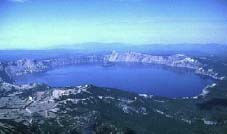Crater Lake Symposium Convenes Researchers
Klamath Kaleidoscope
Fall/Winter 2006
National Park Service
Inventory and Monitoring Program
By DENNIS ODION
A symposium of recent research in Crater Lake National Park was held at the 86the meeting of the Pacific Division of the American Association for the Advancement of Science on 15 June 2005. The meeting was held at Southern Oregon University, in Ashland, Oregon.
Crater Lake is the deepest lake in the United States and internationally renowned for its aesthetic beauty and exceptionally clear water. Although aquatic biomass is limited by a scarcity of nutrients, its aquatic biota are remarkable and fascinating in many respects. The Lake provides a natural laboratory for understanding phenomena important in lakes in which solar radiation penetrates most deeply, as well as dark, deep water habitats throughout the world, including the oceans. Aquatic research highlights presented at the symposium included distribution and abundance of phytoplankton, natural variability in fish populations, and many aspects of the remarkable water chemistry and clarity and movement of deep water to mix with surface waters.
Crater Lake National Park also provides an excellent natural laboratory for studying terrestrial environments, with 266 square miles of subalpine meadows, caves, snowfields, pumice barrens, bogs, old-growth, and timberline forest habitat. There were a number of findings presented from the study of terrestrial environments. These included results of bird and bat inventories, and the response of plants, fungi, and bark beetles to prescribed fires conducted in the park.
The symposium illustrated how a resource protected for public use and enjoyment can also function to provide vital information to the understanding and management of natural ecosystems.
Aerial view of Crater Lake.
***previous*** — ***next***


